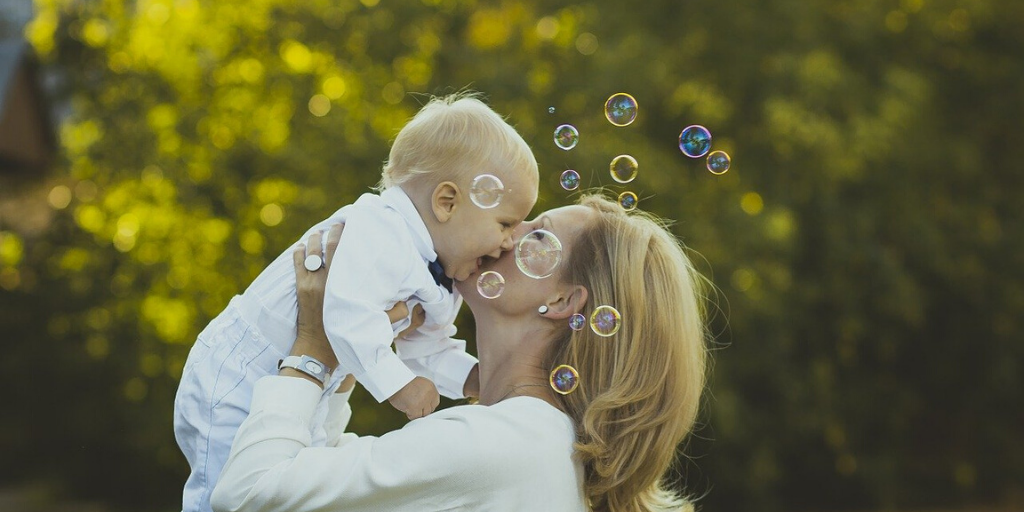
Building Your Baby’s Skills With Bubbles
Bubbles are one of the simplest yet most popular activities for babies and toddlers. They are portable, colorful, and tons of fun! But did you know that playing with bubbles can unlock a multitude of skills for your little one? Read on to find out more!
Bubbles: cheap, simple, endless fun. Bubbles are one of the most basic baby or toddler activities out there - but did you know that bubbles can also be the key to laying the foundations for many life skills for your little one?
In addition to being fascinating and exciting, bubbles are a wonderful way to facilitate the beginnings of a multitude of skills for your baby. Here’s how to use bubbles to benefit your little one’s development.
1. Tracking
When babies reach 2-3 months of age, they can see much more clearly than when they were newborns. Newborn babies can only see about a foot in front of them - but by 8 weeks of age, many babies can begin to track moving objects with their eyes. At this stage, a baby might enjoy laying on a blanket outside and watching a caregiver blow bubbles. This observation can stimulate the coordination between a baby’s brain and eye movements. A young baby can practice tracking the bubbles through the air, both vertically and horizontally, watching their erratic movement and changing shape.
2. Pincer Grasp
Between 5-8 months of age, babies develop their pincer grasp, which is an essential skill for activities such as moving food from a plate or tray to one’s mouth. The pincer grasp refers to the coordinated movement between the thumb and index finger, as opposed to grabbing objects with all the fingers.
3. Hand-Eye Coordination
When a baby reaches for an object, she is practicing hand-eye coordination. Newborns don’t have a very good sense of how to maneuver their body parts, but over time, their brains and muscles strengthen and their hand-eye coordination improves dramatically. When a baby reaches her arm out to try to touch a bubble, her brain is learning how to send important signals to her arm and hand in order to grasp a desired object.
4. Depth Perception
Older babies and toddlers can enjoy running and popping the bubbles. Figuring out how far away the bubbles are from their bodies is a great way to practice depth perception. Depth perception refers to the ability how far away objects are - a skill that is not present at birth. Around the time babies turn five months old, their eyes are developed enough to work together to view the world as three-dimensional. Try blowing bubbles at different heights, or at different distances between you and your little one. Let them figure out how close they need to move to the bubble in order to pop it!
5. Reaching/Jumping
Gross motor (large, full-body movement) skills, like running and jumping, are also important for a child’s development. As your baby learns to walk and turns into a toddler, he will soon practice skills such as climbing (12-24 months), running (18-24 months), and jumping (24-36 months). Your toddler can practice these skills by chasing bubbles in a large outdoor environment.
6. Balance And Physical Coordination
When your little one tries to reach out and pop a bubble, she is solidifying her sense of balance and control. For example, as your toddler chases bubbles, the wind might cause the bubbles to shift direction, and she will need to stop, turn her body, and run in another direction. She will also need to jump and reach without falling over. These skills are vital for building the foundations for more complex physical skills in early childhood.
7. Language Development
Between 12 and 24 months, your toddler’s vocabulary will expand rapidly. By age one, a baby most likely knows 1-3 simple words. By age two, that number increases to 50 or more! Playing with bubbles can be a great way to teach your little one new words. Think of words that describe a bubble’s appearance: round, shiny, colorful, or clear. You can teach your little one about size and shapes by using words like round, small, and big. You can teach your child words about direction by noting whether the bubbles are near or far, high or low. When teaching your toddler language, be sure to speak clearly and concisely. You don’t have to constantly correct your little one’s pronunciation - but be sure that you always pronounce the words correctly and don’t fall into the “baby talk” trap. Children learn through constant repetition and exposure!
8. Hand Dexterity
Toddlers and preschoolers can learn to blow the bubbles themselves. The acts of grasping the wand, dipping it in the bubble solution, and holding it at the right angle so bubbles can be blown out are important skills for developing hand dexterity, which is important for writing.
Bubbles aren’t just fun - they’re educational and can facilitate your baby’s development in a variety of areas! Next time you’re stumped for an easy, exciting learning activity for your little one, go find a container of bubbles and start playing!
Do remember to follow us on Instagram @keababies and join our loving and supportive KeaCommunity Facebook Group!
Parenting is awesome. Sleep is overrated. Every day is an adventure.
|
|
Meet Our KeaMommy Contributor: Kaitlyn Torrez I’m Kaitlyn Torrez, from the San Francisco Bay Area. I live with my husband and two children, Roman and Logan. I’m a former preschool teacher, currently enjoying being a stay at home mom. I love all things writing, coffee, and chocolate. In my free time, I enjoy reading, blogging, and working out. |


























































